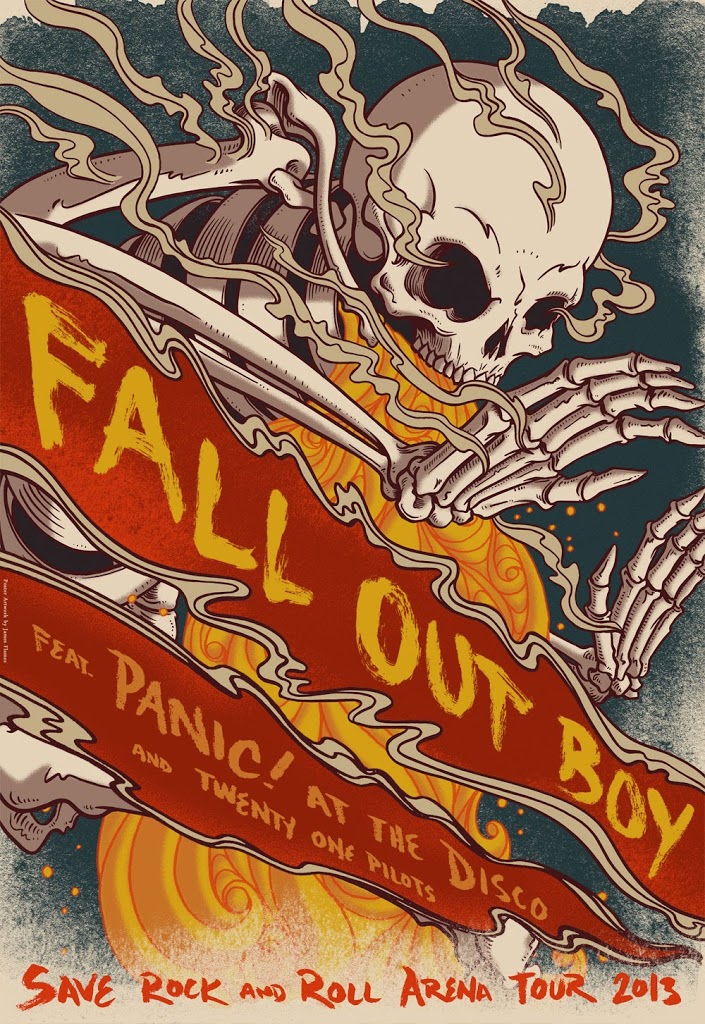Fan the flames of fame without fueling (overly) friendly fire

Fall Out Boy / Panic! At the Disco “Save Rock and Roll” Tour Promo
(Cit. FallOutBoy.com)
If you like music, movies, TV, books, games or basically any kind hobby of moderately common usage at all, then chances are you know (either personally or in recognition) a celebrity in said field you enjoy. Just about every activity has its greatly recognized percentile.
Music doesn’t need fans in order to be composed and saved by someone. One can love and create music for music and creativity’s sake. However, musicians do need fans –especially those of the money spending variety– if those artists are ever going to be able to live off of their music.
A question I had thought to pose via my Pulse over on AAMPP.net, asked users their thoughts on what the “most important thing” was for them, when it came to getting and keeping fans. Seems like an innocent enough enquiry; one with an assortment of potential viewpoints and responses, which I did in fact receive, and you can read, below. Each user is hyperlinked back to their respective AAMPP profiles, so you can check them out further if you’d like:
Tyler Noel(Artist)
Interaction with fans is most important and letting them feel you are a real person
PHATA(Producer)
Providing consistent high quality aural experience that is uplifting and provides energy.
Mike Ogle(Artist)
To be inventive, original and out there… God will do the rest.
Right away, the very first thing that comes to my mind, is the fact that while these three answers are indeed each different, one could argue that a musician could come along, who shows that they are actively doing all three. Something to think about, yes? That aside, these varying ideas, and the initial question in general, do prompt the reminder that there are several ways to acquire fans and public support. What I don’t believe gets looked at adequately in contrast to how one chooses to gain appreciation, is the other side of the coin that might dictate how an artist handles their fans once they have them –and by “handles” I mean more than simply convincing them to keep supporting one’s quest to make music. I’m referring to knowing where and how one’s fans need to be positioned in relation to the artist they love, supposing that one becomes well-known enough to garner more attention than they can attend to by themselves.
Tyler Noel’s response is of particular relevance to this quandary, as along with her and the other two responses, I took to seeing a connection between three different artists who each have impressive leagues of fans but have been the recipients of three very contrastive reactions by their supporters, and not all of them good. Nevertheless, what the musicians did/do have in common, was the fact that each situation that the separate, but similar, fans were reacting to, in some way, breached the artists’ personal lives; each issue hitting upon a topic that went outside of the work involved in making the records and merchandise for which their fans clamored.
Example A:Patrick Stump(of Fall Out Boy)
Example B:Spencer Smith(of Panic! At the Disco)
Example C:Taylor Swift
Patrick Stump’s “fans” are one group I have addressed in the past, in this post from last year. The issues with Swift and Smith are more recent. Stump’s case involved his fans berating and ridiculing him for his (at the time) recent reduction in weight, resulting in a healthier body and more health conscious lifestyle. (This wasn’t a controversy about Stump having an eating disorder or making changes for any excessively vain reasons.) The negative outcries from Stump’s supposed fans was so extreme in nature and large/transparent in number, thanks to the internet, that Stump took to the internet himself, to call out those people and to vent some of his personal hurt and frustration about how he was being treated, even if by droves of people who he didn’t know personally. (The original blog entry is gone but you can read the relevant portion of it quoted in the post hyperlinked above.) The end result of these tirades was not of the worst outcome for genuinely positive fans, which would have been Stump quitting music altogether but the risk was there and the reason for complaint that brought the risk on had essentially no reason for existing because it is Patrick Stump’s body and his body does not belong to his fans. Thinner or heavier, Stump could have written and recorded songs either way, so it’s not even as if his choice one way or the other about weight loss would have affected his cash flow or ability to attend to those people.
Meanwhile, Spencer Smith, whose career in Panic! At the Disco has brought him and bandmate Brendon Urie, into contact and collaboration with Stump on many an occasion, has an inversely affective situation on his hands that does impact his individual fans and those of the collective Panic! fans, quite dramatically. A tour, coincidentally teaming up recently reunited Fall Out Boy with Panic!, which just kicked off at the beginning of the month, came right in the middle of what has now been only a few days packed with a lot of news. This past Monday, August 5, MTV put out a video interview they had with Smith, wherein the singer discusses the trials and tribulations he had to endure to get clean and also talks about coming to grips with what he almost lost as a result of letting drugs and substance abuse control his life. Though material somewhat difficult to hear, the bottom line of Smith being clean was the good news and fans everywhere rejoiced knowing that this timed perfectly with the ability to go on tour and really take life back in after everything Smith had been through. A mere two days later, and just shy of 24 hours ago, Urie posts a lengthy candid message to Panic!’s official website that ends with the declaration that Smith is off to more deeply address his addiction issues and “getting the help that he needs.”
This decision directly impacts if, when and how Smith will ground himself fully in recovery –and hopefully well enough that he can eventually focus on the work that it takes to run a massive national tour. The rest of the dates, most of which have already sold out, will be conducted without Smith and as such, impacts both fans and the music. So, although drug recovery is a serious trial like no other, in a very small, and albeit shallow way, one might be able to understand why fans could become outraged; especially if they have never had any exposure to what the phrase addict can truly connotate for those who have. Still, the aggregate fans of Panic! and Smith seem to be functioning at the complete opposite end of the spectrum from those who tore down Stump. If the mountains of positive comments, emoticons, happy GIFs and pleas for wellness on every social media outlet Panic! has are any indication, those responding are giving only admiration and respect, even if it leaves them with the shorter end of the stick from the point of view of consumerism.
Lastly, we have Taylor Swift with which to contend. Her issue is actually not her issue and, the topic itself is in no way as serious, necessary or immediately affecting, as those for Stump and Smith. Why bring it up then? “Swift’s issue” demonstrates a third complete opposite; hers being entirely divergent from that of Smith: Mid last month, E! Online reported about an up-in-coming clothing company called Bad Kids Clothing, that received (again,) mountains of commentary, from Swift’s fans. However, the feedback came in the form of death threats and implications of impending violence, among other negative scenarios. Something as verbally innocent as a shirt listing names of Swift’s rumored, past boyfriends (pictured below) angered fans so badly that they demanded the shirt be removed from the company’s website and any future production halted. Lex Houser and Andi Cross, the pair who founded “Bad Kids” didn’t bow to the fans but instead responded with their intent not to cave to what they found essentially to be a form of mass cyber bullying:
“Andi and I both had a history of being cyber bullied growing up, and these kids are thinking if they just tell us they’re going to kill us and that 30 million people are going to attack us, that we would just do what they said,”
 |
| (Photo Cit. BadKidsClothing.com) |
Going back to the responses from AAMPP, it is interesting to note that Swift’s situation is the least health critical, the least career (at least with her music) affecting, and frankly, the least connected to her, specifically. Swift didn’t even comment on the situation –neither the shirt nor the emotions of her fans being flung out, death threat style. Yet, she is the one whose fans created the most severe of all the backlashes, while simultaneously being the artist most outwardly and regularly interactive with her fans. Since the beginning of her career Swift has made the transparency of her life a major selling point and point of appeal to fans and parents of fans. These people get to feel close to her not just through the social media every other artist uses but through things like extra long meet and greet lines, personal messages hidden in liner notes, willingness to go above and beyond what her managers and advisors might want, just to make those extra few fans smile.
This approach has always sounded the most endearing and the most grounded and regardless of how one feels about Swift’s vocal abilities, one couldn’t deny her commitment to being a healthy and admired role model. That was when Swift was 16, 17, 18, 19 and 20 though. Is it possible that despite any real intentions Swift has for maintaining a genuine connection with her fans, that doing so has simply moved past the realm of feasibility due to the girth of her brand and ever growing fan base?
Might it be appropriate to say that someone of Swift’s public stature has to pull back on the °bestest girlfriends° approach, if only because at the echelon she is now, pushing that connection while at this level morphs it; from sincere happy fans, to some version of an angry guard dog, ready to bite anything or anyone that comes too close and might put a hair out of place? There’s that fine line between love and hate….
In a way, one can almost visualize a long horizontal scale, with the reactions for these three situations showing what happens when you move from extreme hate, to extreme love. It’s almost poetic and worth writing a song about, isn’t it?
At this moment, does Panic! At the Disco have it right? Do they have the formula down for ideal “fan intimacy” versus “fan sanity,” based on the tempered reactions of their fans? Or does it come down to the age demographic of these different artists/groups? Perhaps it’s as simple as Swift’s pre-teen girl fans not having the same depth of maturity and social media tact as the wider and older age range for the fans of Panic! At the Disco?

Leave a Reply